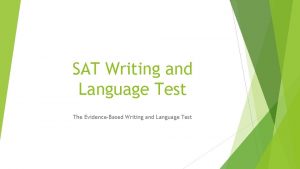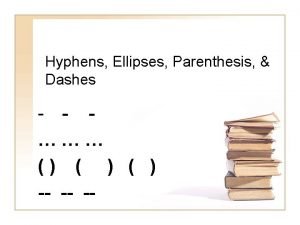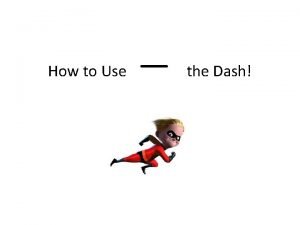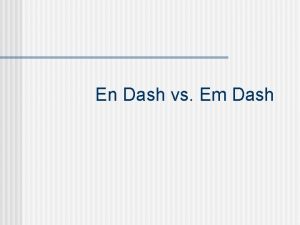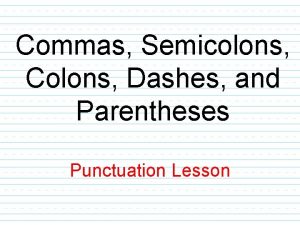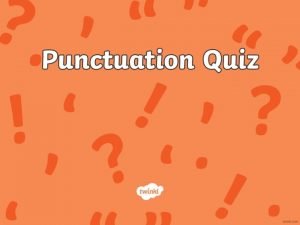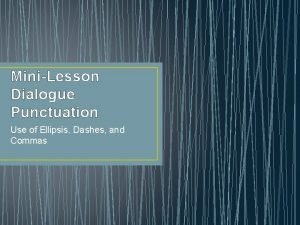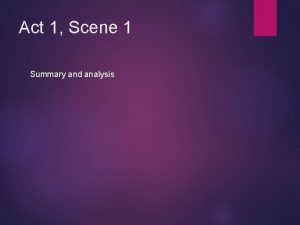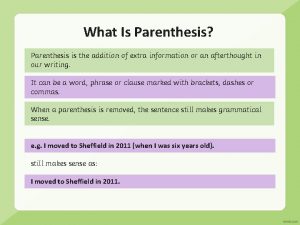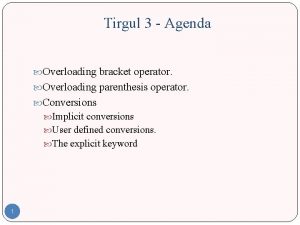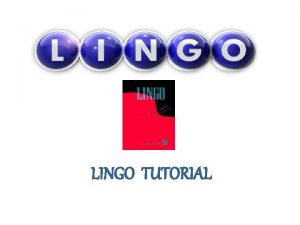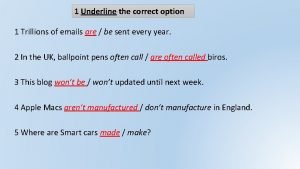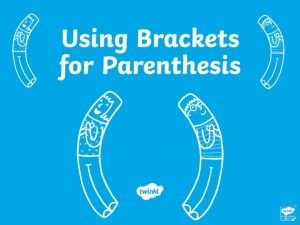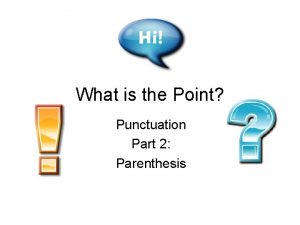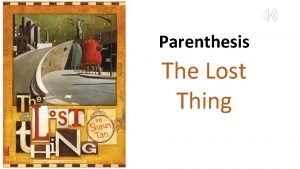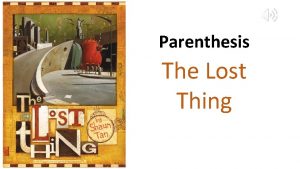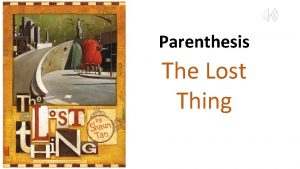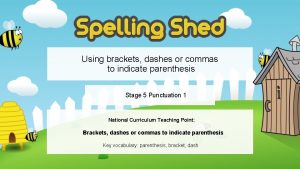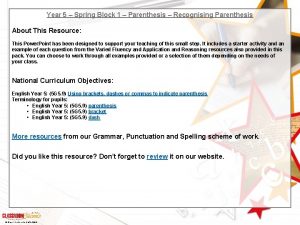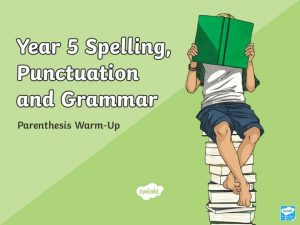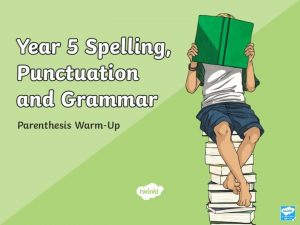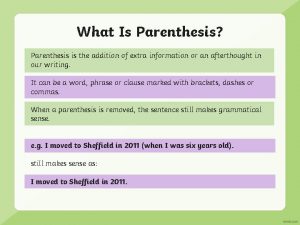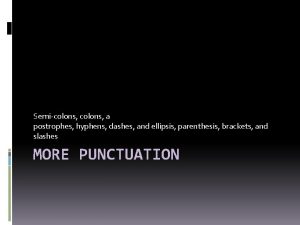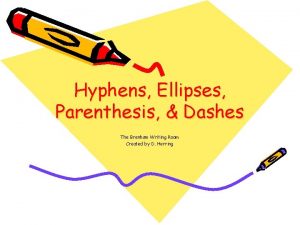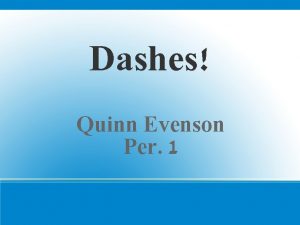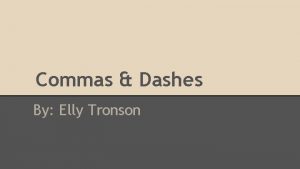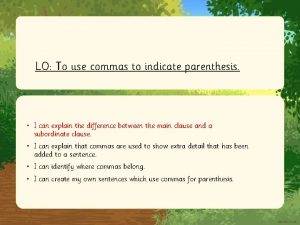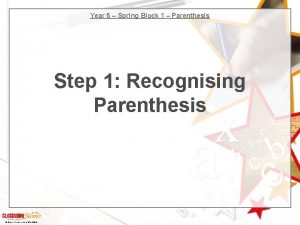Dashes to Indicate Parenthesis Year One I can























- Slides: 23

Dashes to Indicate Parenthesis Year One



• I can use dashes to show parenthesis. • I can explain that dashes surround additional information in a sentence. • I can explain that dashes can be used on their own if the interruption comes at the beginning or end of a sentence. • I can identify where dashes belong. • I can create my own sentences which use dashes to show parenthesis. • I can explain the difference between dashes, paired commas and brackets.


Dashes can perform a similar function to brackets, surrounding additional information in a sentence. Example: The train – which was late – was heading to Paris. Take care not to confuse dashes and hyphens. Dashes are long marks –. Hyphens are short marks . Interesting Fact On old fashioned typewriters, two hyphens typed one after the other were used instead of a dash.

We use a dash to additional information, this extra information is called a parenthesis. There is a space on either side of the dash. Example The man was plainly dressed – so he would not be noticed – in a black suit. The sentence would still make sense without the part within the dashes. This part of the sentence gives extra information so this part could be removed. When a parenthesis is completely removed, the sentence is still grammatically correct. Example: The man was plainly dressed in a black suit. A parenthesis can be separated from the rest of the sentence by commas, dashes, or brackets (all called parentheses).

Two dashes can mark out extra information inserted into a sentence which is grammatically complete without it, similar to brackets. Example James Bond – though I can’t quite believe how – jumped straight over the car, rolled and ran off into the woods. The dashes here add extra information to the sentence like brackets would, but they draw more attention to what is written. Have a go at using a dash in this way on your whiteboard. Task : Create a sentence about James Bond which uses dashes to add parenthesis.

Now let’s play the ‘Dashes for Parenthesis Quiz’. Show the answers to the questions on your whiteboard.

The dash is a punctuation mark which can be used when you want to emphasise additional information. We have already learnt about using a dash in pairs to surround additional information which we want to emphasise. Whereas brackets must always be used in pairs, only one dash is required if the parenthesis comes at the beginning or end of a sentence. A dash found by itself can be used to separate something dramatic (and usually contrasting) at the end of a sentence from the start of the sentence. The idea is to shock/surprise the reader at the very end of the sentence. Example It was a long wait – perhaps the longest of his life. The sentence would still make sense without the part after the dash. There should be a space before and after the dash. This information creates a surprise at the end of the sentence.




How do you know whether to use brackets, dashes or twin commas? Think about these three sentences: Miss Moneypenny (who had travelled from America to England to see James) said the mission was a huge success. Miss Moneypenny, who had travelled from America to England to see James, said the mission was a huge success. Miss Moneypenny – who had travelled from the America to England to see James – said the mission was a huge success. What is the difference between the three?

It is down to the level of importance of the additional information in the middle of the sentence. • Use brackets when the information is an aside or non essential to the reader. • Use commas when the information is of (roughly) equal priority to other facts in the article, and is something you’d like your reader to note and know. • Use dashes when you want to emphasise the information, for some reason.

Discuss Why do you think the writer wanted the information between the dashes emphasised? Miss Moneypenny – who had travelled from the America to England to see James – said the mission was a huge success. Possible Answers • The writer might be trying to convey the sense that the mission was so highly regarded, so worthwhile, that somebody made the effort to travel a long distance to congratulate James. • Alternatively, it may be intended to reflect the strong relationship between James and Miss Moneypenny.

• • • Use brackets when the information is an aside or non essential to the reader. Use commas when the information is of (roughly) equal priority to other facts in the article, and is something you’d like your reader to note and know. Use dashes when you want to emphasise the information, for some reason. Work in pairs to present the three sentences. Think about how the different punctuation would effect they way the sentence is read. Miss Moneypenny (who had travelled from America to England to see James) said the mission was a huge success. Miss Moneypenny, who had travelled from America to England to see James, said the mission was a huge success. Miss Moneypenny – who had travelled from the America to England to see James – said the mission was a huge success.


Add information around the character to show what you have learned about how to use dashes correctly.


Use all of the information you have learned and practised about dashes to show parenthesis. Work on your own to complete the Mini Test Activity Sheet.

Use all of the information you have learned and practised about dashes to show parenthesis. Work on your own to complete the Application Activity.

 Dashes for parenthesis
Dashes for parenthesis When to use dashes sat
When to use dashes sat Dashes hyphens and ellipses
Dashes hyphens and ellipses Different kinds of dashes
Different kinds of dashes Em en dash
Em en dash Alphabet of lines drawing
Alphabet of lines drawing Dash ks2
Dash ks2 What are parentheses used for
What are parentheses used for When to use commas semicolons colons and dashes
When to use commas semicolons colons and dashes Which sentence uses the underlined word correctly?
Which sentence uses the underlined word correctly? Dialogue mini lesson
Dialogue mini lesson Act 1 scene 1 hamlet
Act 1 scene 1 hamlet What is paranthesis
What is paranthesis What is parenthesis
What is parenthesis C++ operator bracket
C++ operator bracket Lingo software tutorial
Lingo software tutorial Underline the correct option to complete the sentences
Underline the correct option to complete the sentences What is a parenthesis
What is a parenthesis What is paranthesis
What is paranthesis Leaving school poems
Leaving school poems One god one empire one emperor
One god one empire one emperor One one one little dogs run
One one one little dogs run One king one law one faith
One king one law one faith One empire one god one emperor
One empire one god one emperor

